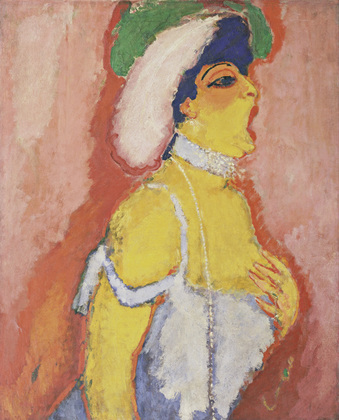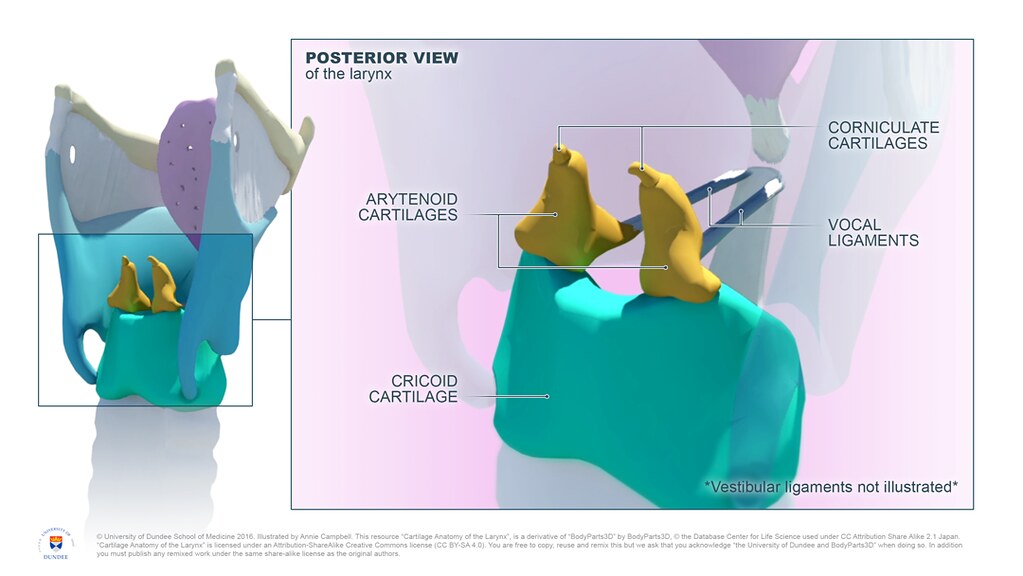
The vocal apparatus
1. Vibratory body (vocal folds)
What are the vocal folds?
- The vocal folds are made of striated muscle fibres, squamous mucosal epithelium (flat cells resembling fishy scales) and collagen elastic fibers (Abitbol 1999, 428).
- Vocal folds are 5mm long in a child, and lengthen with time until puberty, when growth stops. Their full-growth length is approximately 17mm in women, and 23 mm in men (Abitbol 1999, 427).
- The vocal folds are formed in a “V”, laying horizontally, and connecting at the back to the left and right arytenoid cartilages, which are what allow the folds to open and close.
How do they create sound?
- The brain sends out a neurological command telling the folds to vibrate.
- Specifically, it is the vagus nerve (Xth cranial nerve) which makes the larynx open and close (Abitbol 1999, 430).
- The vagus nerve allows the folds to shorten or lengthen and to come together (adduction) or separate (abduction).
The folds are open during inhalation in the shape of their “V”. While singing on the exhalation the “V” closes to form an “I”. The opening and closing of the folds allows for vibration.
Reinke’s space (or lamina propria) is the layer between the muscle and the surface cells of the folds. The kinds of cells that make up this layer are crucial to normal vocal fold vibration (Thibeault 2005, 148). This space allows the muscles to slide together (inferior lip to superior lip – or bottom of “V” to top of “V”) until the folds are completely closed (Abitbol 1999, 429).
- Pitch is changed by the shortening and lengthening of the vocal folds.
- Shorter folds = lower pitch; longer folds = higher pitch (Abitbol 1999, 431).
- Watch the folds elongate as the voice gets higher!
Fun things to know:
- The larynx is placed between the fourth and sixth vertebrae.
- Glandular cells are what hydrate, lubricate and humidify (built in humidifiers!) – the vocal folds do not have any glandular cells on their free edge, but there are some surrounding the folds. This hydration is important to vocal health.
2. Respiration
The breath is the “power source of the vibration”. One can breathe without making sound but cannot make sound without air! Expiratory flow or energy is controlled by the brain. This energy is what controls the voice’s “intensity, its tone, and its regularity” (Abitbol 1999, 430).
3. Resonators
The resonating chamber is made up of the pharynx, the soft palate, the sinuses, the nasal fossae and the postnasal space (the nasal, mouth and throat cavities). This chamber turns sound into voice and creates the vocal colour. A clear vowel sound is created when the lips form vowel shapes (Abitbol 1999, 431).
[toggle title=”References”]Abitbol, J., Abitbol, P. & Abitbol, B. (1999). Sex hormones and the female voice. Journal of Voice, 13:3, 424-446. https://doi.org/10.1016/S0892-1997(99)80048-4.
Thibeault, S. L. (2005). Advances in our understanding of the Reinke space. Current Opinion in Otolaryngology & Head and Neck Surgery, 13(3), 148-151. doi: 10.1097/01.moo.0000163450.90455.fb.
Weill Cornell Sean Parker Institute for the Voice. (2016, July 13). Normal Phonation. [Video]. YouTube.
Weill Cornell Sean Parker Institute for the Voice. (2016, July 13). Pitch Glide. [Video]. YouTube.[/toggle]


Leave a Reply